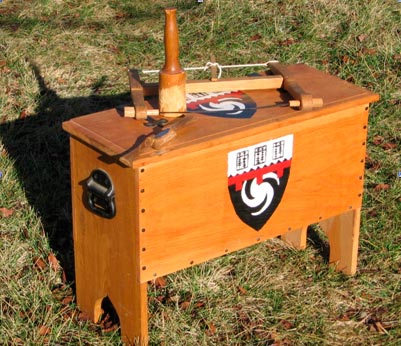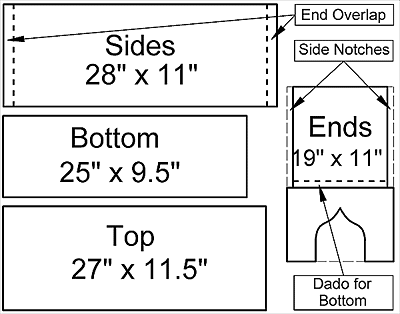A Chest Appropriate for the 12th Century
By Master Kirk Fitzdavid (Kirk Poore)
Introduction

The six-board chest was a common piece of furniture throughout the medieval era, with variations common in all European cultures. It´s quite versatile, since it can be used for storage, seating, or as a table. Handles make it portable. I´ve found these will hold all the usual gear (clothes, shoes, mug) for one person for a weekend event. This particular version is modelled on 14th and 15th century examples, but the basic chest is equally appropriate for the 12th Century as well.
The six-board chest is made, of course, from six boards nailed together – top, bottom, sides, and two legs, which are extended to the ground. The legs (ends) are the key pieces - each as a notch in each side to accommodate the two side boards, a dado (groove) across the middle to help hold the bottom in place, and finally a cutout on the bottom edge to form the feet. Just cut everything out and nail it together. Easy, right? Well, yes, but a little planning and a few tips will make it go faster and let you learn from some of my mistakes.
Materials
- Wood: 13´ of 1x12 pine or 3/4” x 12” oak. Note that a pine 1x12 has an actual size of approximately 3/4” x 11.5”. Current price on two good quality 8´ pine planks is $12.50 at a home center. At hardwood stores, 3/4” x 12 oak will go for about $4-5 per board foot. (Don´t buy hardwood at home centers–it costs way too much.) Total: About $25 for pine or $55 for oak.
- Nails: 1-1/2” cut nails. Lee Valley (LeeValley.com) item 91Z40.03. Approx $11 per pound. One pound will be more than enough.
- Hinges: 10” Strap hinges. Lee Valley item #01H20.52. Approximately $12 each. You need two. Total $24.
- Handles: Cast Iron handles. Lee Valley item #06W03. Approximately $9 per pair.
- Finish: Quart can of boiled linseed oil or small can of polyurethane. About $5 at a hardware store.
Tools
Basic:
|
Optional
|
 Click image of plans for a larger version.
Click image of plans for a larger version.Continued, Part II

